PC malfunctions detected during the boot phase. The computer is not started correctly: what to do
All Windows operating systems, including the most stable seventh or the newest tenth version, are characterized by the appearance of failures when the system does not boot in normal mode and informs the user that the computer has not started correctly. What is the reason and how to deal with it, see below.
The computer did not start correctly (Windows 8.1, 8, 10): the main causes of failures
As for the reasons causing this behavior of the system, there can be a lot of them. According to statistics, most often such failures occur due to improper shutdown of the computer, forced stopping of some processes (for example, updates), damage system files or even the bootloader itself.
The most common are failures with error descriptions like INACCESSIBLE_BOOT_DEVICE (inaccessible boot device), CRITICAL_PROCESS_DIED (interrupted critical process), or something like that.
Very often, notifications that the computer is not started correctly and because of this Windows cannot start in normal mode can be found in case of voltage drops, when the terminal spontaneously disconnects from the network when there is no uninterruptible power supply or stabilizer, when the power supply overheats, etc. .d. We should also pay special attention to the functionality of all "iron" components. But these are trifles. Situations look much worse when the system contains viruses that violate Windows work, or for some reason the components responsible for loading the system fail. Let's consider a few common cases of such problems and the main methods for eliminating them, without touching on problems with the "hardware".
What's the first thing to do?
So, if suddenly a situation occurs when the computer is not started correctly and the system cannot start, it may very well be that this is a fleeting failure. In this case, first you need to reboot the system or just turn off the terminal in the usual programmatic way from the Start menu.
If this is not possible, you will have to apply forced shutdown by long pressing the power button on system unit or on the laptop panel.
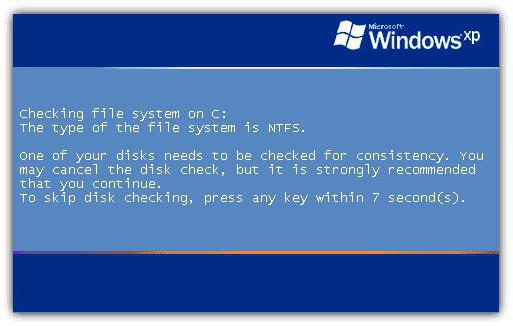
As a rule, after such a procedure, at startup, the system initiates a check of the system disk for errors, after which it can boot in normal mode. The visual check can be observed in Windows 7 and below. In later versions, it is done in the background.
Virus check
Equally important if a message appears that the computer has not started correctly is system diagnostics for the presence of virus threats. If the system does not start at all, it is quite problematic to do this.
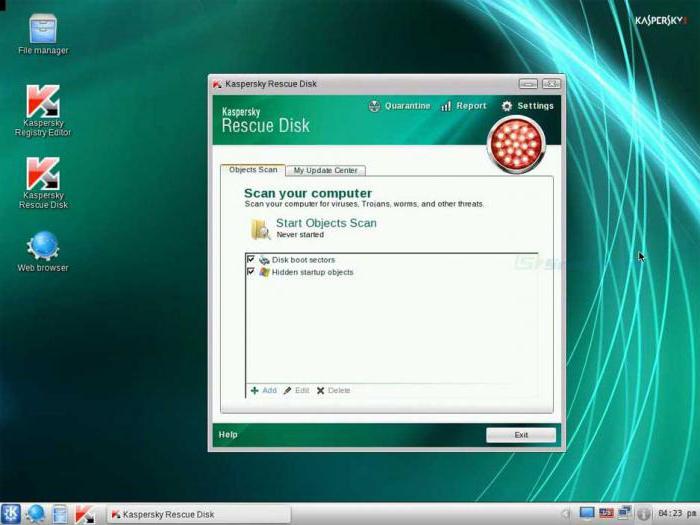
Therefore it is recommended to use special utilities like Kaspersky Rescue Disk, from which it boots even before Windows starts. In the utility itself, to facilitate the task, you can use its own graphical interface, and it works much better than stationary scanners, allowing you to identify many threats even in RAM or boot sectors.
Automatic recovery. The computer does not start correctly (Windows 10 and below)
In general, almost all recent Windows systems are characterized by the presence of a special self-recovery module after critical failures. This is the so-called automatic recovery. The computer did not start correctly, the system does not boot, although there are signs of operability. In this situation, System Restore should start automatically.
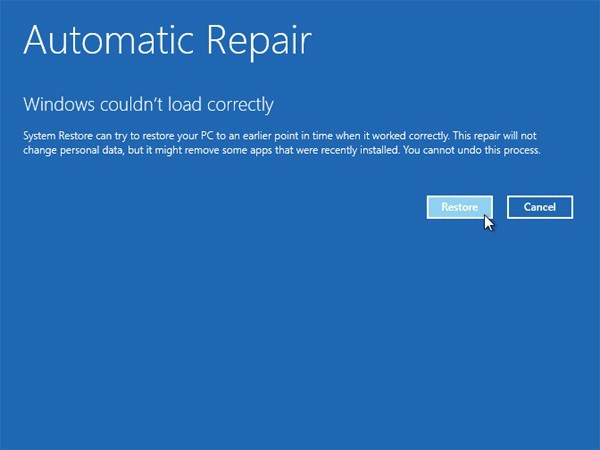
A corresponding notification about the start of the analysis for system recovery appears on the screen. But this only works if Windows has a fixed rollback point. If the user cleaned or deleted previously created ones before the crash, nothing will work. The backup simply does not have a copy from which to roll back to the previous state.

In the seventh version operating system and below, fixing this situation looks much easier. When starting the system at the boot stage, use the F8 key, which is used to select safe mode boot, but in the menu that appears, you need to select the boot of the last working configuration (again, if possible). By the way, in the tenth version it is also possible to configure the use of the F8 key to call such a menu.
Loading in with checking the integrity of system files
The situation is somewhat more complicated with the damage to the system components of the system with the inability to restore them in automatic mode (at startup or restart after the notification that the computer has not started correctly). What to do in this case?
To begin with, you can try to boot in safe mode, and then use the command line invoked from the Run console (Win + R). If for some reason this boot option is not possible, you should set safe mode with confirmation in command line to determine the component where the download stops. In this situation, the command line will have to be called from installation disk.
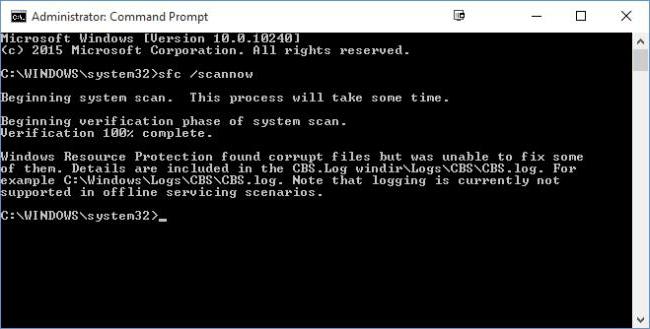
In both cases, sfc / scannow is written on the command line, after which the system will automatically check and restore the failed components. But this does not always help.
Disable driver signature verification
Now let's look at the situation when the computer does not start correctly (Windows 10 on board). In the tenth version, getting to the safe mode is quite problematic. Here you will need an installation or recovery disk, when booting from which in the recovery section you need to select additional settings and go to diagnostics and then use the boot options menu.
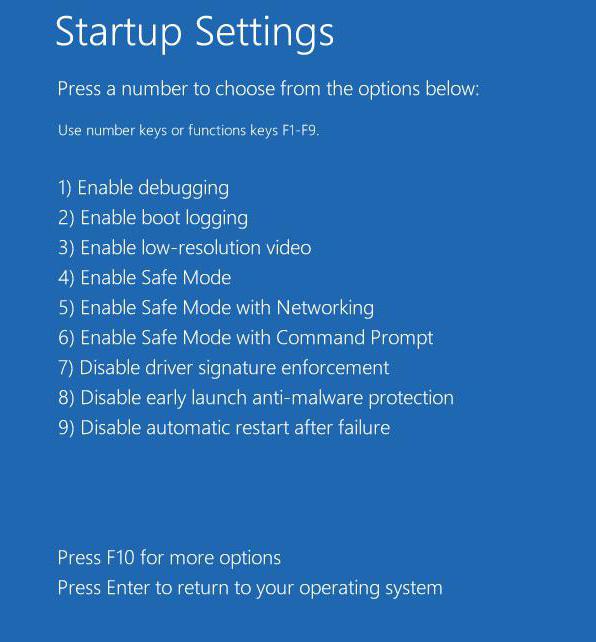
In the menu that appears, there is a line for disabling the verification of the digital signature of drivers, which is under the seventh number. You need to move to it and press the enter key (you can do this faster by pressing the number 7 on the keyboard).
This problem is very often associated with the oem-drc64.sys driver. If disabling signature verification worked, you need to enter the registry editor (regedit in the Run menu) and go down the HKLM branch through the SYSTEM section to the CurrentControlSet directory, which contains the Services directory. Find the driver folder here and delete it.
Restoring the system from an image
It is believed that the best option for restoring the system to work after a message is displayed that the computer is not starting correctly (Windows 10 is in use or any other version) is to restore from a previously recorded system image.
Not everyone, however, thinks about such things in advance, nevertheless, the very process of putting Windows in order in this case turns out to be the fastest and simplest.
Using the command line with an incomplete or aborted update
There are also situations when problems with the fact that the computer did not start correctly (8.1, 8, 7 or 10th modifications on board) are associated with an incomplete or interrupted system update. You can also fight these failures.
We call the command line at boot, as shown earlier, and write the command shown below there:
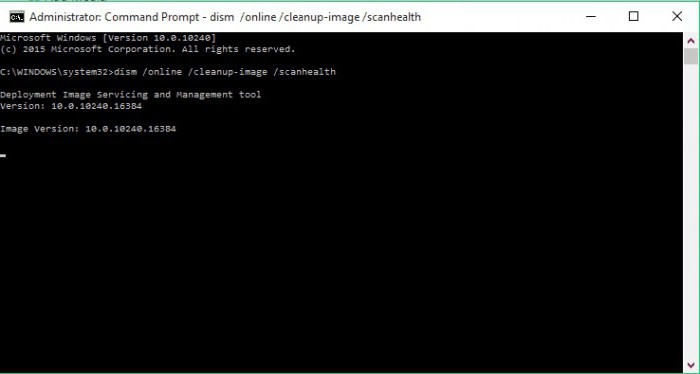
Hard recovery commands
If this option does not help, the computer is not started correctly and the system does not boot, you can try to do an authoritative recovery.
To do this, first write three commands on the command line:
- diskpart;
- list volume;
- exit.
Be sure to remember the letter of the system partition, as in most cases it will differ from the generally accepted value "c" (most often the system partition "e" will appear).

After entering each command, the enter key is pressed. In theory, this method gives an almost 100% guarantee of Windows recovery.
Boot Loader Repair
Finally, if the computer does not start correctly, Windows of all versions offers another universal solution that allows you to restore the bootloader, which may be damaged.
To do this, in the same command console, you must first use the command chkdsk checks c: / f / r followed by the restore directives directly, as shown below:

Then you can reboot. The system, if the failure was associated with the bootloader, will work like a clock.
If all else fails
Finally, about one more situation when none of the above does not help. Have to do reinstalling Windows... But, in order not to "demolish" the entire system, when booting from the installation disk in the diagnostics section, you need to select the item to return the computer to the so-called initial state.
This approach provides for the option of saving user files, after which it will be possible to produce a "clean" Windows installation, which in most cases allows you to get rid of software failures much better than all the checks combined. But this, as it is already clear, should be done only in the most extreme case, when all other means were powerless.
Instead of a total
Finally, it remains to add that the situation when the computer is not started correctly or the system does not start can be connected precisely with the "hardware". In particular, problems with graphics chip or hard drive when it starts to "crumble". If these are really physical problems, there is nothing to be done. But for the correct determination of malfunctions, additional diagnostic tools should be used. Only in the case of correctly identifying the cause of the failure and the failing component, it is possible to determine the correct solution to eliminate such consequences.
As for all other cases, it is believed that at least one of the above proposed methods will work. So it remains to advise you to use the troubleshooting options, moving from simple to more complex methods. But in any case, so that such excesses do not occur in the future, it is better to take care in advance of creating a system image or a recovery disk, recording antivirus utilities, etc. It's quite easy to do this, even with your own Windows tools... Such tools should be at hand for any user, as they say, in the most unforeseen case, because none of the currently used Windows systems are immune to failures.
Under this definition, it would be appropriate to include such user complaints as “does not work”, “does not load”, “freezes”, “a black screen appears and the computer hangs”, “ blue screen and everything ”and the like. Cases when "does not turn on", that is, the computer does not respond with sound or light indicators to pressing keyboard keys, or "does not start", that is, something will sound there or some indicator will light up, but on the monitor screen even moment does not appear meaningful information, this article is not considered.
Let's take a look at the most offensive case when a desktop computer or laptop is under warranty from the manufacturer. What can and should be done by yourself before contacting an authorized service center?
The first thought of the user when such a nuisance arises is that the manufacturer is to blame, he sold a low-quality product. This is often true. But not always. The problem is that a computer exists in the interaction of two hypostases - hardware, vulgarly called "hardware", and software... The computer manufacturer is responsible only for the hardware, for the software there is no warranty service at all, at best it is provided technical support software developer and only for legal users.
Localization of a malfunction, whether it is hidden in the hardware or there was a failure in the software, that is, solving the dilemma "hardware" or "mathematics" - this is the first task of the engineer service center... And the point here is not even so much in deciding to whom to attribute the cost of troubleshooting. The main point is the difference in elimination methods. Replacing faulty components, and finding out the reasons for the failure of the program, these are completely different specialties. A user of any skill level can perform preliminary diagnostics. This does not require any special knowledge, the more complex diagnostic equipment - vibration tables, refrigerators for cooling, ovens for heating. All you need is the willingness to perform a series of simple steps, a known good optical drive, and one to three regular CDs. Another important thing is knowledge of diagnostic techniques. The technique consists of three steps, and an effective result may appear after completing the first.
Diagnostics
Step one - checking the RAM. Step two - checking the surface hard disk... Step three is to check the functionality of the software. The first and second steps can be swapped based on intuition. For example, if the "blue screen of death" of the Windows operating system appears, then it makes sense to start by checking the RAM. If the computer "thinks" when loading the operating system, then you can save time by starting to check the surface of the hard disk. The first two steps identify the vast majority of all hardware faults. Only after making sure that the RAM and hard disk are in good working order can you proceed to finding out the operability of the software. At this stage, it is very likely that it is not the manufacturer of the device that is to blame, but the "peripheral device of the computer control program", there is a chance to save a lot of nerve cells.
About preparing bootable CDs... If you are not prejudiced against the Linux operating system, it is enough to download and burn to disk the installation distribution kit, for example, ubuntu of any available version. This is enough to complete all three diagnostic steps. Two disks are needed if it is preferable to use tools other than those offered by the Linux installation distribution to check the hard disk surface. Linux installation distributions come with a memory tester called memtest86. It is freely redistributable, regularly updated. software... If for some reason another program is required, then it becomes necessary to prepare a third disc. Describing how to prepare bootable disks is beyond the scope of this article.
Learn more about checking RAM... The memtest86 program works without an operating system, it should be run before loading it. Once launched, the program can run indefinitely. It is believed that after 24 hours of continuous operation without the appearance of error messages, we can assume RAM serviceable. If errors appear in the first minutes of work, then you can safely begin to sharpen your teeth on the computer manufacturer - this is a hardware malfunction.
Learn more about checking the hard disk surface... If you prefer to use Linux tools, then to check it is enough to run the program to copy the entire disk area accessible to the user to the / dev / null device. If it is impossible to read the faulty sector of the disk, the program will exit with an error message. There is only one drawback of this method - the program works very slowly and silently. There are faster universal programs for example Victoria. In addition, each manufacturer of hard drives offers its own, factory programs designed for diagnostics. An important point for laptop owners who are under warranty. If a hard drive is found to be defective, the manufacturer is obliged to replace the hard drive with a serviceable one with pre-installed software for this laptop model.
A few words about software performance check... An ubuntu installation distribution is sufficient for most cases. For those who are not familiar with Linux, this is a great opportunity to get acquainted. In addition, in the event of a hard disk malfunction, if it is possible to mount a disk partition with important data, then you can save them by uploading them to external memory. If there is no time and you urgently need to do some work, then you can find Linux designed to work without installing on HDD for example a Knoppix assembly.
If you found this article helpful, please vote for it. This will help others find this article more quickly from many other less useful ones.(1 Voice)
This manual will describe step by step ways to fix the problem when booting Windows 10 on the "Automatic Repair" screen, you see a message stating that the computer did not start correctly or that Windows system loaded incorrectly. We will also talk about possible reasons such a mistake.
First of all, if the error "The computer has not started correctly" occurs after you turn off the computer or after interruption Windows updates 10, but it is successfully corrected by pressing the "Restart" button, and then it appears again, or in cases where the computer does not turn on the first time, after which an automatic recovery occurs (and again everything is corrected by a restart), then all the actions described below with command line - not for your situation, in your case the reasons may be as follows. Additional instructions with options for system startup problems and their solutions:.
If the error appears after resetting Windows 10 or updating
One of the simplest options for the appearance of the error "The computer did not start correctly" is something like the following: after a reset or update of Windows 10, a "blue screen" appears with an error like INACCESSIBLE_BOOT_DEVICE(although this error can be an indicator of more serious problems, in the case of its appearance after a reset or rollback, everything is usually simple), and after collecting information, the "Recovery" window appears with the "Advanced options" button and restart. Although the same option can be tried in other error scenarios, the method is safe.
Go to Advanced Options - Troubleshooting - Advanced Options - Boot Options. And click the "Restart" button.

In the Boot Options window, press 6 or F6 on your keyboard to launch Safe Mode with Command Prompt. If it starts, log in as an administrator (and if not, then this method does not work for you).

In the command line that opens, use the following commands in order (the first two may display error messages or take a long time to freeze in the process. Wait.)
- sfc / scannow
- dism / Online / Cleanup-Image / RestoreHealth
- shutdown -r
And wait for the computer to restart. In many cases (in relation to the appearance of the problem after a reset or update), this will fix the problem by restoring Windows startup 10.
"The computer did not start correctly" or "Windows does not seem to boot correctly"

If, after turning on the computer or laptop, you see a message that the computer is being diagnosed, and then a blue screen with a message that "The computer has not started correctly" with a proposal to restart or go to additional parameters (the second version of the same message is on the "Recovery" screen (message that Windows did not boot correctly), this usually indicates damage to any system Windows files 10: registry files and more.

The problem can manifest itself after a sudden shutdown when installing updates, installing an antivirus or cleaning the computer from viruses, cleaning the registry using cleaners, installing questionable programs.
And now about the ways to solve the problem "The computer is not started correctly." If it so happened that you had automatic creation of restore points enabled in Windows 10, then first of all it is worth trying this option. This can be done as follows:
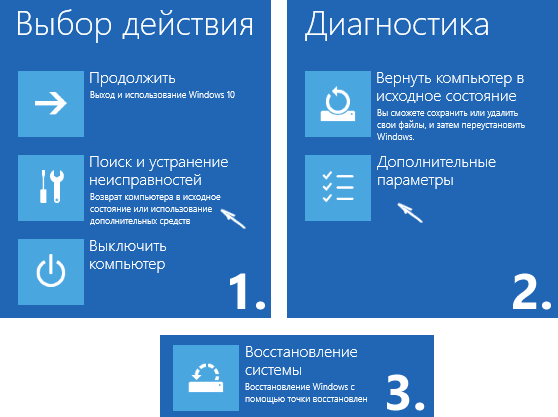
After pressing the cancel button, you will be taken to the blue screen again. Click on it "Troubleshoot".
Now, if you are not ready to take all of the following startup restore steps that will use command line only, click Reset this computer to reset windows 10 (reinstallation), which can be done while saving your files (but not programs). If you are ready and want to try to return everything as it was - click "Advanced options", and then - "Command line".
In the command line, we will check the integrity of the system files and Windows 10 components in order, try to fix them, and also restore the registry from backup... All of this together helps in most cases. Use the following commands in order:
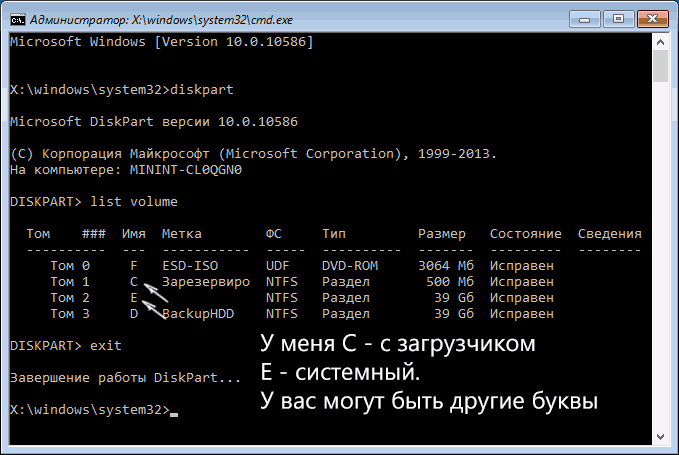
There is a good chance that Windows 10 will start up after that. If not, you can undo all the changes made in the command line (which can be run in the same way as before or from the recovery disk) by returning the files from the backup we created:
- cd e: \ configbackup \
- copy * e: \ windows \ system32 \ config \(confirm overwriting files by pressing A and Enter).
 Bugs in Singularity?
Bugs in Singularity? Just Cause 2 crashes
Just Cause 2 crashes Terraria won't start, what should I do?
Terraria won't start, what should I do?